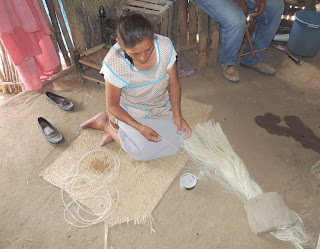I have been working on a tour of the area about Tenancingo for the last 6 months.
We will be hosting 14 people from the states for a week and Peter is the
tour guide. It's a trip actually visiting places I have passed for so long,, finally making the time to "investigate the ticker". This has been a very positive experience for me. Anything
that reminds one of their ignorance promotes humility and that is the
best condition for learning. Tenancingo has varied identities.
"Commercial" being the strongest,, with its flower and vegetable markets,
and myriad business Tenancingo's surface presentation seems soiled,, but one must always scratch the surface, no? It's just a stone's throw away to paradise if we bend over to pick up the stone.
Yesterday I went to a town called Zumpahuacan near Tenancingo to set up a meeting with
two mescaleros for the tour. Everyone sees "Zumpa" as a place of tribes that settle disputes with guns and knives. This has never been my experience. The day was hot. Zumpahuacan is drier
than Tenancingo and desertified, the mountainous landscape sparsely
dotted by, cactus, acacias, and palmettos. After sipping a mezcal with a
mezcaleros wife, Tomasa, I left their porch decorated with hanging maracuyas to
firm up a lunch for the tour at a reataurant close by. That done I
wanted to find some people who wove items of ixtle,, the fibrous
structure of cactus leaves. After receiving varied directions, and
visiting some dead ends, I ended up on a steep hill awash in sweat and
a little desperation. A lady wrapped in a rebozo was passing. ¿Señora,
perdon, hay personas aqui que hacen cosas de ixtle? Si yo,, she replied.
In the course of a short conversation she told me she was heading to her workshop
and invited me to come along. I told her to hop in the pick-up and we climbed higher up the road.
Matilde Casanova Arellano told me to pull over by the water tank. We
exited and walked down a path on the edge of a scraggly corn field. The sun made me feel like greasy bacon until we
passed under some large trees that gave relief from the intense heat.
Her workshop was in the distance,, part cement block and part carrizo. Some chickens scratched and cackled.
Her daughters were inside and they invited me in. I had to duck to enter
the low door made of carrizo and hung with rope hinges. The room was a small oval and the light
pierced the upright stalks of carrizo that made the walls slicing the room into shafts of cafe and
yellow.
The floor was fine packed dirt and there was a bed.
Just like that she began to work
showing me every stage of the operation from the joshua trees outside
from which they harvested the raw material for their weaving to the
finished product. Something isn't dying, at least yet,, and someone here
and in many places about this diverse world is still making something
useful and beautiful from what is all around them. They participate in
that special club of people outside the chase yet carrying on. Matilde
talked throughout the work in clear tones as if she were made more alive
by her craft. She told me her father taught her,, and his father taught
him. I thought this craft must be
thousands of years old.









Great story about ixtle. Thanks
ReplyDelete